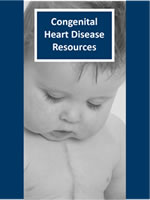Children and Youth with Special Health Needs (CYSHN)
Programs
Contact Info
Hypoplastic Left Heart Syndrome
Condition Description
Hypoplastic left heart syndrome (HLHS) is a severe congenital defect of the heart where the left side of the heart does not develop normally during early weeks of fetal development. The cause is unknown.
The left sided pumping chambers (left atrium, left ventricle) are very small and the two important valves (aortic and mitral) are either absent or underdeveloped. The flow of blood through the heart is very different because of the underdeveloped left side of the heart. Blood that comes from the lungs and contains oxygen flows through an opening between the upper pumping chambers (atrial septal defect, ASD) and then reaches the body through the ductus arteriosus that is connected to the aorta. Because the ductus arteriosus closes in the first few days of life the baby will seem normal initially and then become very ill once that vessel closes due to the reduced amount of oxygenated blood flow to the body. The baby's color will become grayish-blue because of the low level of oxygen (called cyanosis).
Children will need to have frequent follow-up with cardiologists, including stress tests to assess their limits for exertion. It will be very important to continue to see a cardiologist to monitort their blood pressure and the heart valves are functioning well.
- Our program has been tracking hypoplastic left heart syndrome among live births in select counties since 2005 and gradually expanding statewide.
Using data from births statewide between 2016-2020, we found that 2 babies were born with hypoplastic left heart syndrome per 10,000 births.
Using this data, we estimate about 12 babies are born with hypoplastic left heart syndrome every year in Minnesota.
